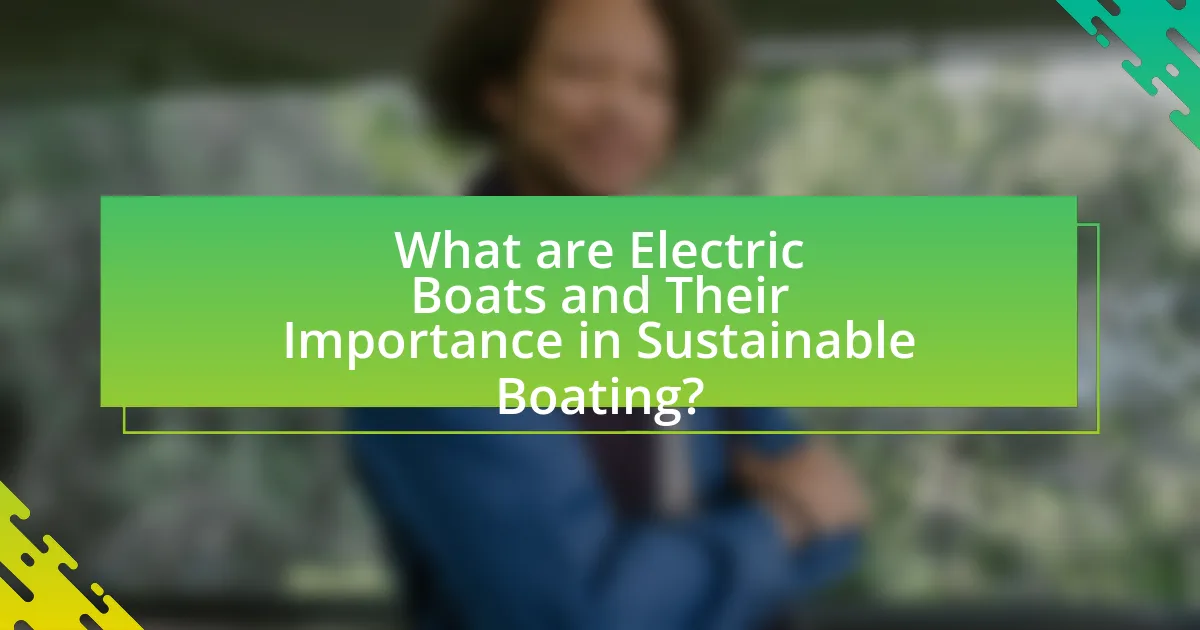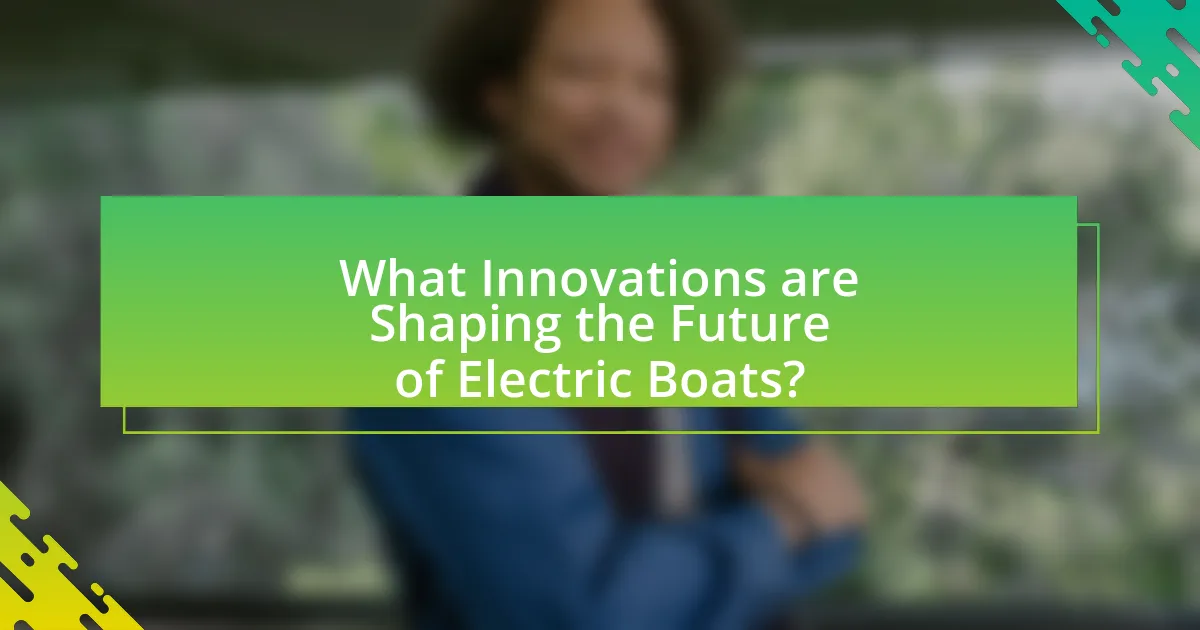Electric boats are watercraft powered by electric motors and batteries, offering significant advantages over traditional combustion-engine vessels, particularly in terms of sustainability. This article explores the importance of electric boats in reducing greenhouse gas emissions and water pollution, highlighting their environmental benefits and the technologies that power them, such as advanced battery systems and renewable energy integration. It also examines emerging trends in the electric boat industry, the challenges faced in market adoption, and the regulatory landscape shaping innovation. Key practices for maximizing efficiency and maintenance of electric boats are discussed, emphasizing their role in promoting sustainable boating practices for the future.

What are Electric Boats and Their Importance in Sustainable Boating?
Electric boats are watercraft powered by electric motors and batteries instead of traditional internal combustion engines. Their importance in sustainable boating lies in their ability to reduce greenhouse gas emissions and minimize water pollution, contributing to cleaner waterways and a healthier marine ecosystem. According to a report by the International Council on Clean Transportation, electric boats can significantly lower emissions compared to gasoline-powered vessels, with some models achieving up to 90% reduction in carbon emissions. This shift towards electric propulsion aligns with global efforts to promote renewable energy and sustainable practices in the maritime industry.
How do Electric Boats differ from Traditional Boats?
Electric boats differ from traditional boats primarily in their propulsion systems; electric boats use electric motors powered by batteries, while traditional boats typically rely on internal combustion engines fueled by gasoline or diesel. This fundamental difference leads to several advantages for electric boats, including reduced emissions, quieter operation, and lower maintenance costs. For instance, electric boats produce zero tailpipe emissions, contributing to cleaner waterways and air quality, whereas traditional boats can emit significant pollutants. Additionally, electric motors have fewer moving parts compared to combustion engines, which simplifies maintenance and reduces long-term operational costs.
What technologies power Electric Boats?
Electric boats are powered primarily by electric propulsion systems, which include electric motors and batteries. These systems utilize lithium-ion batteries for energy storage, providing efficient power to the electric motors that drive the boat. The integration of advanced technologies such as regenerative braking and solar panels further enhances the sustainability and efficiency of electric boats. For instance, lithium-ion batteries are known for their high energy density and longevity, making them a preferred choice in marine applications. Additionally, the use of solar panels can supplement battery power, allowing for extended range and reduced reliance on shore charging.
What are the environmental benefits of using Electric Boats?
Electric boats significantly reduce environmental impact by eliminating harmful emissions and minimizing noise pollution. Unlike traditional gasoline or diesel-powered vessels, electric boats operate on batteries, which produce zero tailpipe emissions, thereby improving air quality and reducing greenhouse gas contributions. According to the International Maritime Organization, shipping accounts for approximately 2.5% of global greenhouse gas emissions; transitioning to electric propulsion can help mitigate this issue. Additionally, electric boats contribute to less water pollution since they do not leak oil or fuel into waterways, protecting aquatic ecosystems. The quieter operation of electric boats also reduces noise pollution, benefiting marine wildlife and enhancing the overall boating experience.
Why is the Future of Electric Boats Significant?
The future of electric boats is significant due to their potential to reduce environmental impact and promote sustainable boating practices. Electric boats produce zero emissions during operation, which helps to decrease water pollution and protect marine ecosystems. According to a report by the International Council on Clean Transportation, transitioning to electric propulsion can significantly lower greenhouse gas emissions associated with recreational boating. Additionally, advancements in battery technology are enhancing the range and efficiency of electric boats, making them more viable for a broader range of users. This shift towards electrification aligns with global efforts to combat climate change and supports the growing demand for eco-friendly transportation options.
What trends are emerging in the Electric Boat industry?
Emerging trends in the Electric Boat industry include advancements in battery technology, increased adoption of hybrid systems, and a focus on sustainable materials. Battery technology is evolving with the development of solid-state batteries, which offer higher energy density and faster charging times, enhancing the range and efficiency of electric boats. The adoption of hybrid systems is growing as manufacturers seek to combine electric propulsion with traditional engines, providing flexibility and reducing emissions. Additionally, there is a significant emphasis on using sustainable materials in boat construction, driven by consumer demand for environmentally friendly products. These trends are supported by market research indicating a projected growth rate of over 20% in the electric boat sector by 2027, reflecting a shift towards greener boating solutions.
How do Electric Boats contribute to reducing carbon emissions?
Electric boats contribute to reducing carbon emissions by utilizing electric propulsion systems that produce zero tailpipe emissions during operation. Unlike traditional gasoline or diesel-powered boats, which release greenhouse gases and pollutants into the atmosphere, electric boats rely on batteries charged from renewable energy sources, further minimizing their carbon footprint. According to a study by the International Council on Clean Transportation, transitioning to electric vessels can reduce emissions by up to 90% compared to conventional marine engines, highlighting their significant role in promoting cleaner waterways and combating climate change.

What Innovations are Shaping the Future of Electric Boats?
Innovations shaping the future of electric boats include advancements in battery technology, electric propulsion systems, and renewable energy integration. Enhanced lithium-ion batteries, such as those developed by companies like Tesla, offer higher energy densities and faster charging times, significantly improving the range and efficiency of electric boats. Additionally, electric propulsion systems, including direct-drive motors, provide quieter and more efficient operation compared to traditional combustion engines. Furthermore, the integration of solar panels and wind turbines on boats allows for renewable energy generation, reducing reliance on shore power and enhancing sustainability. These innovations collectively contribute to a more eco-friendly and efficient boating experience.
How is Battery Technology Evolving for Electric Boats?
Battery technology for electric boats is evolving through advancements in energy density, charging speed, and sustainability. Recent developments include the use of lithium-sulfur and solid-state batteries, which offer higher energy densities compared to traditional lithium-ion batteries, allowing for longer ranges and reduced weight. For instance, lithium-sulfur batteries can theoretically provide up to five times the energy density of lithium-ion, significantly enhancing the performance of electric boats. Additionally, rapid charging technologies are being implemented, enabling boats to recharge in shorter time frames, which is crucial for practical use. Furthermore, manufacturers are focusing on environmentally friendly materials and recycling processes to minimize the ecological impact of battery production and disposal, aligning with the sustainability goals of the boating industry.
What are the latest advancements in battery efficiency?
Recent advancements in battery efficiency include the development of solid-state batteries, which offer higher energy density and improved safety compared to traditional lithium-ion batteries. Solid-state batteries utilize a solid electrolyte instead of a liquid one, significantly reducing the risk of leaks and fires. Research from the Massachusetts Institute of Technology indicates that these batteries can achieve energy densities exceeding 500 Wh/kg, which is a substantial improvement over current lithium-ion technologies that typically range from 150 to 250 Wh/kg. Additionally, advancements in battery management systems and fast-charging technologies are enhancing the overall performance and longevity of batteries, making them more suitable for applications in electric boats.
How do these advancements impact the range of Electric Boats?
Advancements in battery technology and energy efficiency significantly enhance the range of electric boats. For instance, the development of lithium-sulfur batteries has increased energy density, allowing electric boats to travel longer distances on a single charge. Research indicates that these batteries can potentially offer up to 500 Wh/kg compared to traditional lithium-ion batteries, which typically provide around 150-250 Wh/kg. Additionally, improvements in hull design and propulsion systems reduce drag and increase overall efficiency, further extending the operational range of electric boats. These innovations collectively contribute to making electric boating more viable for longer journeys, thereby expanding their usability in various marine environments.
What Role do Renewable Energy Sources Play in Electric Boating?
Renewable energy sources play a crucial role in electric boating by providing sustainable power for propulsion and onboard systems. These energy sources, such as solar, wind, and hydropower, reduce reliance on fossil fuels, thereby decreasing greenhouse gas emissions associated with traditional boating. For instance, solar panels installed on electric boats can harness sunlight to charge batteries, enabling longer trips without the need for conventional fuel. According to a report by the International Renewable Energy Agency, integrating renewable energy into marine transport can lead to a significant reduction in carbon emissions, supporting the transition to greener boating practices.
How can solar power be integrated into Electric Boats?
Solar power can be integrated into electric boats by installing photovoltaic panels on the boat’s surface to harness sunlight for energy generation. These solar panels convert sunlight into electricity, which can be used to charge the boat’s batteries or power onboard systems directly. For instance, a study by the National Renewable Energy Laboratory indicates that integrating solar panels can significantly extend the operational range of electric boats by providing a renewable energy source, reducing reliance on traditional charging methods. Additionally, advancements in lightweight solar technology allow for efficient energy capture without compromising the boat’s performance or design.
What are the benefits of using wind energy for Electric Boating?
The benefits of using wind energy for electric boating include reduced fuel costs, lower emissions, and enhanced sustainability. Wind energy harnesses natural forces, allowing electric boats to operate with minimal reliance on fossil fuels, which significantly cuts operational expenses. Additionally, utilizing wind energy contributes to a decrease in greenhouse gas emissions, promoting a cleaner marine environment. According to the International Renewable Energy Agency, integrating wind energy into marine applications can lead to a 50% reduction in carbon emissions compared to traditional fuel sources. This shift not only supports environmental goals but also aligns with the growing demand for sustainable boating solutions.

What Challenges do Electric Boats Face in the Market?
Electric boats face several challenges in the market, primarily including limited battery technology, high initial costs, and regulatory hurdles. Limited battery technology restricts the range and performance of electric boats compared to traditional fuel-powered vessels, as current lithium-ion batteries may not provide sufficient energy density for longer trips. High initial costs deter potential buyers, as electric boats often require a larger upfront investment than their gasoline counterparts, despite lower operating costs over time. Regulatory hurdles, such as varying environmental regulations and lack of standardized charging infrastructure, complicate the adoption of electric boats in different regions. These challenges collectively hinder the widespread acceptance and growth of electric boats in the marine market.
What are the current limitations of Electric Boat technology?
The current limitations of Electric Boat technology include limited battery capacity, which restricts range and operational time, and longer charging times compared to traditional fuel sources. For instance, many electric boats can only operate for a few hours before needing a recharge, significantly impacting their usability for longer trips. Additionally, the availability of charging infrastructure in marinas and coastal areas is still underdeveloped, making it challenging for users to find convenient charging options. Furthermore, the initial cost of electric boats remains high, which can deter potential buyers despite lower operational costs over time. These factors collectively hinder the widespread adoption and practicality of electric boating technology.
How does the cost of Electric Boats compare to traditional options?
Electric boats generally have a higher upfront cost compared to traditional gasoline or diesel-powered boats. For instance, electric boats can range from $20,000 to over $1 million, while traditional boats often start around $10,000. However, electric boats offer lower operating costs due to reduced fuel expenses and maintenance needs. According to a study by the International Council on Clean Transportation, electric boats can save owners up to 50% in fuel costs over their lifetime compared to traditional options. This cost comparison highlights the initial investment versus long-term savings associated with electric boating.
What infrastructure is needed to support Electric Boating?
Electric boating requires a robust infrastructure that includes charging stations, maintenance facilities, and designated docking areas. Charging stations are essential for recharging electric boats, similar to electric vehicle charging networks, and should be strategically located at marinas and popular boating destinations to ensure accessibility. Maintenance facilities must be equipped to handle the specific needs of electric propulsion systems, including battery management and electrical systems. Additionally, designated docking areas that accommodate electric boats can facilitate easier access to charging and maintenance services, promoting the use of electric vessels. This infrastructure is vital for the growth and sustainability of electric boating, as it addresses the logistical challenges associated with transitioning from traditional fuel-powered boats to electric alternatives.
How are Regulations Impacting the Development of Electric Boats?
Regulations are significantly influencing the development of electric boats by establishing standards for emissions, safety, and performance. These regulations, such as the International Maritime Organization’s (IMO) guidelines on greenhouse gas emissions, compel manufacturers to innovate and adopt cleaner technologies. For instance, the European Union’s Green Deal aims to reduce carbon emissions from maritime transport, pushing electric boat developers to enhance battery efficiency and integrate renewable energy sources. Compliance with these regulations not only drives technological advancements but also shapes market dynamics, as companies that meet or exceed regulatory requirements gain competitive advantages in the growing eco-conscious consumer base.
What are the key regulations affecting Electric Boat manufacturers?
Key regulations affecting Electric Boat manufacturers include the Clean Water Act, which governs discharges into U.S. waters, and the Clean Air Act, which regulates air emissions from marine vessels. These regulations ensure that electric boats meet environmental standards for emissions and water quality. Additionally, manufacturers must comply with the U.S. Coast Guard’s safety regulations, which include standards for electrical systems and battery safety. Compliance with these regulations is essential for market access and operational legality in the U.S. boating industry.
How do these regulations promote or hinder innovation?
Regulations can both promote and hinder innovation in the electric boat industry. On one hand, regulations that set clear environmental standards can drive innovation by encouraging companies to develop cleaner, more efficient technologies to meet these requirements. For example, the International Maritime Organization’s regulations on greenhouse gas emissions have prompted manufacturers to invest in advanced battery technologies and energy-efficient designs. On the other hand, overly stringent regulations can stifle innovation by imposing high compliance costs and limiting design flexibility. For instance, complex certification processes can delay the introduction of new electric boat models, discouraging investment in innovative solutions. Thus, the impact of regulations on innovation in electric boating is contingent on their design and implementation.
What are the Best Practices for Adopting Electric Boats?
The best practices for adopting electric boats include assessing energy needs, selecting appropriate battery technology, ensuring proper charging infrastructure, and prioritizing energy efficiency. Assessing energy needs involves calculating the required power for specific boating activities, which helps in choosing the right electric motor and battery capacity. Selecting appropriate battery technology, such as lithium-ion, is crucial due to its high energy density and longevity, which can enhance performance and reduce replacement costs. Ensuring proper charging infrastructure is essential, as access to charging stations can significantly impact usability; this may involve installing home charging solutions or utilizing public charging networks. Prioritizing energy efficiency through design choices, such as lightweight materials and hydrodynamic shapes, can maximize range and performance. These practices are supported by industry trends showing that electric boats can reduce operational costs and environmental impact, making them a sustainable choice for the future of boating.
How can boaters maximize the efficiency of Electric Boats?
Boaters can maximize the efficiency of electric boats by optimizing battery management, utilizing energy-efficient navigation techniques, and maintaining the vessel properly. Effective battery management involves monitoring charge levels and using regenerative braking to extend battery life. Energy-efficient navigation techniques, such as planning routes to avoid strong currents and using optimal speeds, can significantly reduce energy consumption. Regular maintenance, including checking for hull fouling and ensuring the propulsion system is functioning efficiently, also contributes to better performance. Studies indicate that proper maintenance can improve energy efficiency by up to 20%, demonstrating the importance of these practices in maximizing the efficiency of electric boats.
What maintenance tips are essential for Electric Boat owners?
Electric Boat owners should regularly check and maintain their battery systems, as these are critical for performance and longevity. Regularly inspecting battery connections for corrosion, ensuring proper charging practices, and monitoring battery health can prevent issues and extend battery life. Additionally, owners should clean the hull to reduce drag and improve efficiency, as a clean hull can enhance the boat’s performance. Routine checks of the electric motor and propulsion system are also essential to ensure optimal operation, as these components can wear over time. Following manufacturer guidelines for maintenance schedules and using appropriate cleaning and maintenance products will further support the longevity and efficiency of electric boats.




